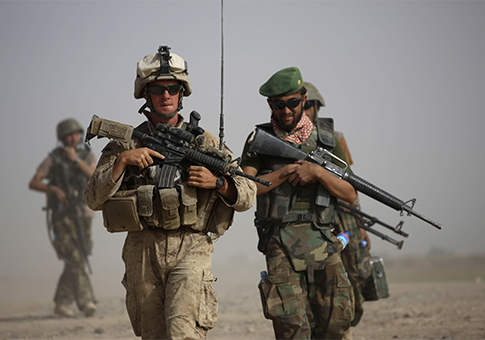So-called "insider attacks" on coalition forces in Afghanistan have sharply increased and become more coordinated as America pulls out of the country, jumping by 120 percent from 2011 to 2012 alone, according to Pentagon report released Tuesday.
Afghans with ties to terrorists continue to infiltrate the security forces and carry out planned attacks against U.S. soldiers and other forces, according to an unclassified Pentagon report.
These deadly attacks by Afghan soldiers have only increased and become more sophisticated as the Obama administration continues its exit from the war-torn nation, the Pentagon reported.
"There was a 120 percent increase in insider attacks from 2011 to 2012, rising from 22 to 48 incidents," the report states. "Additionally, 29 percent (14) of the insider attacks in 2012 were executed by more than one person. Prior to 2012, only two attacks had been executed by more than one individual."
There have been 172 "insider attacks" on U.S., Afghan, and coalition military forces from Jan. 1, 2007 to March 31, 2013, according to the report.
More than 100 of these attacks were carried out against the International Security Assistance Force (ISAF), which includes U.S. forces.
Seventy attacks were launched directly on U.S. personnel, the report states.
More than 140 ISAF personnel were killed during these attacks, while another 208 were wounded. U.S. forces suffered 92 casualties from these insider attacks, while another 134 were wounded, according to the report.
The United States has spent $54 billion in total to arm, train, and sustain Afghanistan’s security forces, including purchasing more than $1 billion in bullets for the Afghan National Army (ANA.)
The Pentagon also found that the ISAF had incorrectly tallied past attacks, leading officials to underreport the number of dead and injured.
"ISAF reassessed its historical attack database, looking for incidents that were actually insider attacks but had been incorrectly categorized," the report says.
This resulted in "an increase of the previously reported total number of insider attacks over the 2007-2012 period."
Eleven incidents from 2007 to 2012 were "reclassified as insider attacks," while another three from 2013 were added, according to the report.
Most of these insider attacks were carried out by those with ties to terrorists or by individuals who felt that Western forces had disrespected their religion, the Pentagon found.
"Roughly half of the attacks in 2012 involved some level of insurgent links, with a third of those only making contact with insurgents after their attack," the report says, noting that none of the attacks could be attributed to "personal disagreements."
Afghan troops have attacked coalition forces for numerous "cultural insults," according to the report.
These include "the mishandling of religious materials, an incident in which coalition forces showed disrespect to insurgent remains, and the release of inflammatory religious videos and cartoons," according to the Pentagon.
Eighty percent of these attacks were carried out against coalition force, ANSF forces, or on joint bases. Twenty percent took place during joint patrols, according to the report.
"The majority of attackers were between 17 and 25 years old," the Pentagon found.
Additionally, "most attacks occurred in the provinces that contain high numbers of coalition forces and are the centers of traditional areas of insurgent strength within the Pashtun belts," according to the report.
Attackers chose their victims randomly, "not on the basis of their rank or position" in most cases.
Following the "spike" in insider attacks in 2012, coalition forces implemented several new "counterintelligence" protocols.
Intelligence teams were assembled to "vet, collect, analyze and interview persons of interest and to exploit biometric data, documents and media," according to the Pentagon.
These new methods have helped forces "detect and neutralize" 94 "insider threats," the report found.
Nine of these would-be terrorists had "insurgent ties," while another 85 "posed an insider threat," according to the report.
